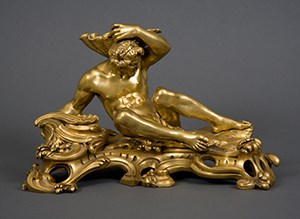
An 1887 editorial in the American journal Art Amateur noted there was no abatement in the rage for drawing-rooms in the style of the three monarchs who last sat upon the French throne. . . . The copyists are kept very busy, and the supply from that source at least shows no danger of giving out. . . . Mrs. William Henry Vanderbilt’s Louis XIV salon of course is famous; but it is not finer than the Louis XV salon of Mrs. William K. Vanderbilt. . . . For Mr. Cornelius Vanderbilt’s Louis XVI music room, the oak paneling all came out of an old French chateau. In September of 1897, Charles McKim asked Stanford White to “Look up old room in Paris Style Louis XVI, and if you find anything worth while, cable,” indicating that Hyde Park would also have a French salon. White’s search did not produce the antique paneling. Instead, the Vanderbilt’s decorator Georges Glaenzer recreated a richly-paneled Louis XV-style room inspired by French design sources. Reception rooms such as this were reserved for receiving guests and entertaining small parties. Ogden Codman and Edith Wharton commented on the infrequent of these rooms in their book The Decoration of Houses: Whatever the genealogy of the American drawing-room, it must be owned that it too often fails to fulfil its purpose as a family apartment. It is curious to note the amount of thought and money frequently spent on the one room in the house used by no one, or occupied at most for an hour after a “company” dinner. . . . The library, or den, where the members of the family sit, may be furnished with shabby odds and ends; but the drawing-room must have its gilt chairs covered with brocade, its vitrines full of modern Saxe, its guipure curtains and velvet carpet. As observed by the Vanderbilt butler Alfred Martin, this room was, in fact, used very little. Tea might be served here for very special guests—Eleanor Worcester remembered having tea in this room during a weekend visit—or a small group of eight to ten dinner guests would congregate here until dinner was announced. Martin also tells us that Mrs. Vanderbilt used the room when she wanted to be alone, noting “when the door was closed that was a sure indication that Mrs. Vanderbilt did not want to be disturbed.” Furnishings of Note
InkwellThis 19th-century inkwell in the form of a river god in the Louis XV style was made in the atalier of French cabinetmaker Paul Sormani. The reclining nude figure holds a scallop-shell on his shoulders and is seated on a scrolling and foliate base flanked by a scallop-shell hinged lidded well. Sormani modified the ancient Roman tradition of showing reclining nude male figures leaning against upturned water urns as symbols of rivers. In this example, he substitues the urn for a shell. 
Armchair (fauteuil à la reine)The giltwood curvilinear forms, high relief decoration, and floral silk upholstery are hallmarks of Louis XV furniture. This chair, one of a pair, was possibly made in the atalier of Jules Allard in the nineteenth century and retains its original silk brocade upholstery. Valuable textiles made from silk and gilt metal threads were an essential feature of formal furniture, often bestowed upon royal furniture. Silk brocades, such as seen here, are among the costliest of fabrics. |
Last updated: January 28, 2022
